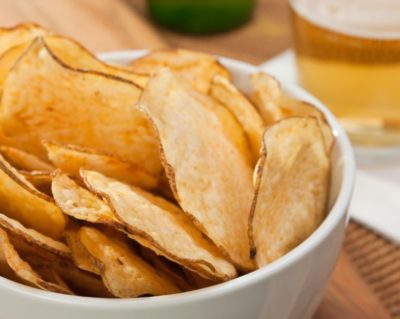
Inexpensive, easy–to-store and versatile in its many preparations, the potato is probably a staple in your pantry and your garden. You are accustomed to baking them whole, frying them or tossing them sliced or diced into soups and stews and all sorts of baked dishes. Potatoes are a great source of carbohydrates, potassium and vitamin C, and potato skin is high in fiber.
However, your experience with eating potatoes in their popular “chip” form may be limited to only the store-bought varieties. It’s time to try making your own potato chips. It’s easier than you think and when you bake them in the oven with just a little oil and salt, they are a more healthy option.
The potato chip, which is near or at the top of snack food favorite lists, was invented back in 1853 right here in the U.S.A. and not as a result of a culinary experimentation but rather as a way to deal with a complaining restaurant customer.
Native American George Crum was the chef at the Moon Lake Lodge, a Saratoga Springs, New York resort in the summer of 1853. On his menu were the popular thick-cut French style potatoes (French fries) that were likely first introduced to America by Thomas Jefferson, our ambassador to France from 1785 to 1789. Records show that “potatoes served in the French manner” was listed on the Jefferson White House menu in 1802.
Are You Ready For The Coming Food Riots?
One of Chef Crum’s Moon Lake Lodge dinner guests thought his French fries were too thick and sent his order back to the kitchen. Crum sliced and fried a new thinner batch for the customer, who still was displeased. An exasperated Crum then decided to make a statement by preparing a batch of potatoes so thin that that the customer would not even be able to pick up them up with his fork.
Crum’s “so there” plan misfired. The guest loved the browned paper-thin potatoes, and other guests requested them as well. Now don’t feel too sorry for old George. He was able to parlay his idea for potato chips – and the reputation he built as a result — into opening his own restaurant near Saratoga Lake in 1860, where he served a wealthy clientele that included the Vanderbilt and the Hilton families until 1890.
It’s not known for certain who first had the idea of selling potato chips in grocery stores, but one of the first was William Tappendon in 1895. He converted a barn behind his Cleveland, Ohio, house into one of the nation’s first potato chip factories. In the 1920s Herman Lay, founder of the H.W. Lay Co., which is now part of the Frito-Lay corporation, invented the mechanical potato peeler and mass production of potato chips became possible.
One of the best things about making your own potato chips is that you can tweak them according to your tastes. Thick or thin, with peel or without, russet or sweet potato, coconut oil or olive oil, sea salt or table salt — it’s up to you. What you won’t be adding is any extra artificial flavorings, colorings or preservatives that many store-bought chips contain.
All you really need is an oven and a cookie sheet to get started on your homemade chips. You’ll find that you’ll want to experiment with your chips after you’ve gotten the hang of it. Also If you like your chips very thin, a mandoline slicer comes in handy. Here’s a basic recipe to get you started:
Ingredients:
3 medium russet potatoes, scrubbed, dried and sliced into 1/8-inch slices (You can peel them if you like.)
3 tablespoons olive oil
Sea salt to taste
Preparation:
Preheat the oven to 425°F.
Slice potatoes thinly with sharp knife or mandoline slicer
Arrange slices in single layer on an oiled cookie sheet
Drizzle potatoes with oil
Sprinkle with sea salt
Bake for 8 to 12 minutes or until crispy (Look for the edges to start to curl up)
Watch closely to prevent over-baking
Serve warm or store in an air-tight container
Variation:
Bake 5 to 7 minutes on one side and then flip potatoes to other side for 5 to 7 minutes for even browning.
Tips:
Blot potatoes dry before baking
Watch potatoes closely during baking since they can burn easily
Options to sprinkle on your chips just after they come out of the oven when there is still enough oil for the ingredients to cling to: Parmesan cheese, ancho chile powder, smoked paprika, ground cumin, toasted sesame seeds, minced herbs, Old Bay seasoning, ground pepper, ground nori. You could even go fancy by serving your warm potato chip with crème fraiche and thin slices of smoked salmon. (Warning: Your kids will think some of these options are sacrilege!)
Other ideas: Don’t stick with russets. Try the following potatoes for different flavor and color to your meals:
Yukon gold – Gold on the outside and yellow on the inside with a rich, buttery flavor.
Red potatoes – Firm, round and moist with a thin skin.
Sweet potatoes – Choose small- to medium-sized sweet potatoes, which are sweeter and creamier than the larger varieties. The skin should be firm and smooth. Generally, the deeper the color of the potato, the higher the concentration of the antioxidant beta-carotene.
Sign up for Off The Grid News’ weekly email and stay informed about the issues important to you